I haven't blogged in quite a while due to lack of time and the near-disappearance of the Second Life art that interests me. But Theda Tammas fortunately has not disappeared, and her new installation, integrated with numerous videos by Iono Allen and featuring music composed by Morlita Quan, is surely one of her best. Genesis has several themes, but I will focus on a less obvious one: how it meditates on the building blocks of digital creativity itself--its genetic code. Discerning this theme requires a little prior knowledge, and I suspect there are aspects of it in the installation that I missed. However, even though the reasons for my interpretation are technical, they are I think easily grasped once pointed out. But I'll get to that.
The installation's entryway is a pathway through which the most prominent displays are several videos of her animesh statues walking, often showing only their legs which seem to be made of wire, their arms, and occasionally faces wearing strange masks that look somewhat like wire traps. In some scenes, the animesh figures hang in the air. One can hear music that sounds like a chorus singing. (SL is terribly temperamental with video, so you may have difficulties getting one or two to play; sometimes all you can do is come back later. You may need to toggle video a couple times to hear the music.) (To enlarge the photos, right-click them and select "Open link in new tab.")
 |
| Video scene from Genesis |
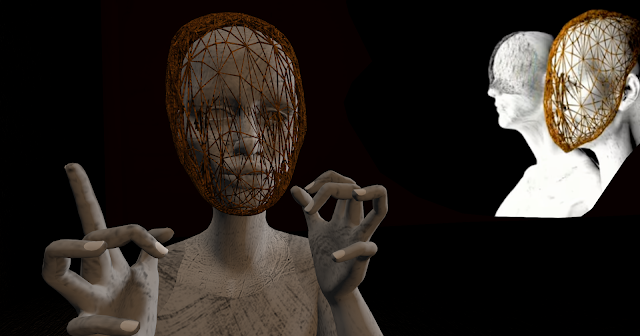 |
| Construction at Genesis |
At the end of the path there's an animesh statue (seen above), fingers wriggling, facing a wall that looks somewhat like a well-weathered picket fence made of lath. Walk into the wall and you'll be teleported to the installation's upper level. (There are also two surfaces immediately below it visible through the translucent ground, the first of which has a long "picket fence," and there's a "sky" surface above.) Varied constructions are scattered across the landscape, many of them inhabited by the animesh figures, all of them with wire legs and some wearing the wire mask. Some of the constructions integrate videos. The "picket fences" also re-appear, or a version of them. Red curves sweep upward like staircases. The most prominent build looks like an undulating wave but actually consists of lines, or more precisely, flat surfaces of varying shapes. The scene and the videos are both beautiful and unnerving.
 |
| Construction at Genesis |
 |
| Construction at Genesis |
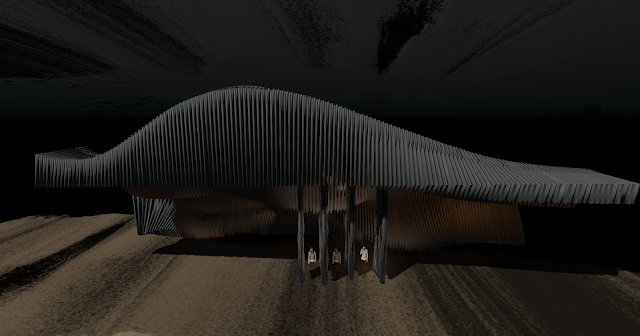 |
| Construction at Genesis: the "Wave" (front view) |
 |
| Construction at Genesis: the "Wave" (a side view) |
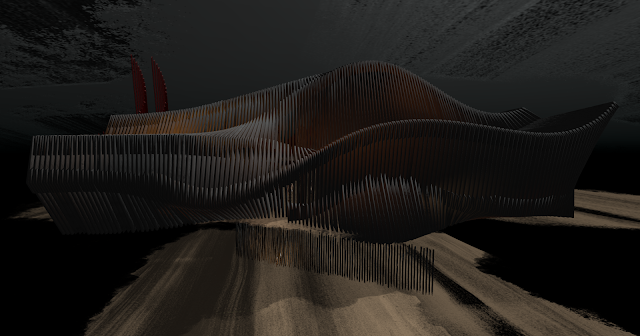 |
| Construction at Genesis: the "Wave" (rear view) |
The way the "Wave" is constructed is striking, particularly the fact that there is no actual wave, but instead a virtual one suggested by vertical lines. The method is precisely the same as used for digital sound recording: at regular intervals, one samples and records the amplitude of the wave, like this:
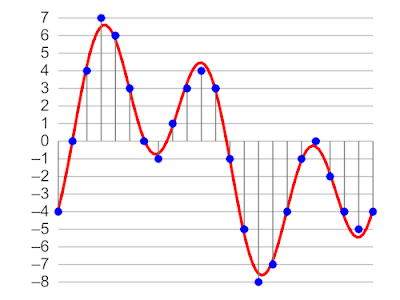 |
| A sound wave, in red, represented digitally, in blue By Aquegg - Own work, CC BY-SA 3.0, https://commons.wikimedia.org/w/index.php?curid=29599378 |
The digital audio recording consists of only the blue dots, and the sequence of vertical lines illustrates the sampling time interval. (Notice also that the amplitudes offer only fixed steps for values, so there's a level 6 and a level 7, but no 6.75, resulting in some approximation. That's digitization for you!) Clearly, in the picture above, the dots' replication of the red wave is, well, spotty; the more frequent the sampling (more blue dots), the clearer the representation of the sound wave. (Movies in the celluloid era likewise used rapidly displayed photos to give the impression of movement.)
Theda's "Wave" works the same way. I should say that to my knowledge, its three-dimensional aspect doesn't correspond to anything in the digital world, but it certainly makes for a more arresting visual image. And when viewed from behind (see above), one discovers that the "Wave" consists of several different waves woven together. Examined closely, the "picket fences" and the red upward curves are similarly built of parallel pieces that appear to be positioned at regular intervals. The red curves may even use fixed steps for their heights, although this is hard to determine. Morlita's music itself--and let's remember the illustration of digital sound above--seems to follow the digital principle too: through most of it, the "chorus" sings a single note ten times, and then switches to a different note.
But if one can digitally create what seems like a sound wave through a series of points (the blue dots), how does one represent a three-dimensional object? Theda and Iono give us a hint by forcing us to examine the animesh statues' legs, which seem to be made of wire. Which digitally they are: as a sort of sampling for efficiency, three-dimensional objects are represented by using triangles of various shapes and sizes. (This is why curved prims like disks look like polygons when very large.) The system is called "wireframe." Here are photos of the same image at Genesis, one as you usually see it, the other displaying the wireframes.
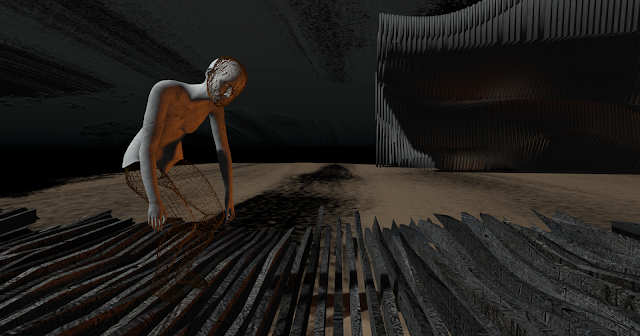 |
| Image at Genesis: standard view |
 |
| Image at Genesis: wireframe view |
Almost literally, the legs show the underpinnings of digitally represented bodies. You can display wireframes yourself anywhere in SL: turn on the Developer menu under Advanced, and under the Developer menu, choose Rendering, and then Wireframe--or for a shortcut, just press Ctrl-Shift-R (this toggles).
(You may notice that the wires creating the legs form quadrilaterals, but that's probably to simplify construction; the wires themselves use extremely thin triangles. But the wires that compose the masks do form triangles.)
No doubt most visitors to Genesis won't notice these technical aspects of the art, as the images, videos and music are far more apparent and have a strong sensory and emotional impact. And rightly so. But these elements suggest why detailed attention to the images and music--the technique behind the poetry--is rewarding and enriches their meaning, and its digital "genetic code" may explain why the installation is titled Genesis.
Be sure to pick up the gift at the entrance. It consists of a red curve as the floor, a "picket fence," and standing in front of it one of the wireframe-legged figures: a sort of thumbnail of the entire build. I set it up in my home, making a pedestal for it out of--logically enough--one of the basic building blocks in SL: a single cubical prim, which I suitably reshaped.
 |
| Gift from Genesis on a one-prim, contorted cube pedestal |
Iono Allen has a video of the entire installation at https://www.youtube.com/watch?v=5CnYJkad2H0
Please note that to get the best experience of Genesis, you should use Ultra graphics settings.
For a good interpretation of the poetic aspects of Genesis, see the blog post by Yoon.
Genesis is at La Maison d'Aneli <http://maps.secondlife.com/secondlife/Virtual%20Holland/19/19/3057>
I would like to thank Aneli Abeyante, curator of La Maison d'Aneli, for hosting this superb installation.
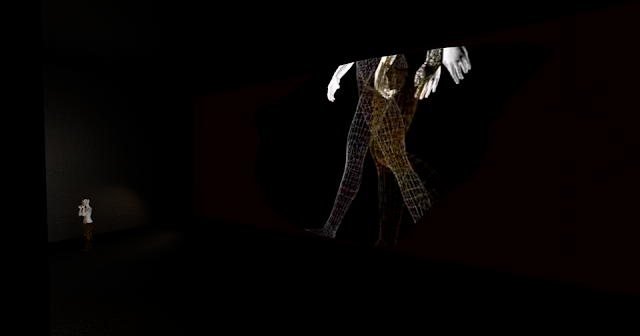
No comments:
Post a Comment